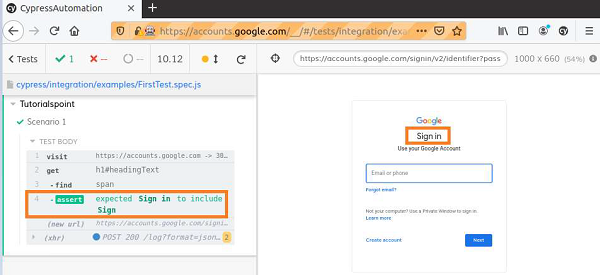
- Cypress教程
- Cypress - 主页
- Cypress - 简介
- Cypress - 架构和环境设置
- Cypress - 测试运行者
- Cypress - 构建第一个测试
- Cypress - 支持的浏览器
- Cypress - 基本命令
- Cypress - 变量
- Cypress - 别名
- Cypress - 定位器
- Cypress - 断言
- Cypress - 文本验证
- Cypress - 异步Behave
- Cypress - 使用 XHR
- Cypress - jQuery
- Cypress - 复选框
- Cypress - 标签
- Cypress - 下拉菜单
- Cypress - 警报
- Cypress - 子窗口
- Cypress - 隐藏元素
- Cypress - 框架
- Cypress - 网络表
- Cypress - 鼠标操作
- Cypress - cookie
- Cypress - 获取和发布
- Cypress - 文件上传
- Cypress - 数据驱动测试
- Cypress - 提示弹窗
- Cypress - 仪表板
- Cypress - 屏幕截图和视频
- Cypress - 调试
- Cypress - 自定义命令
- Cypress - 装置
- Cypress - 环境变量
- Cypress - 挂钩
- Cypress - JSON 文件的配置
- Cypress - 报告
- Cypress - 插件
- Cypress - GitHub
- Cypress有用资源
- Cypress - 快速指南
- Cypress - 有用的资源
- Cypress - 讨论
Cypress - 断言
Cypress 从 Mocha、Chai 等各种库中获取了不止一种类型的断言。断言类型有显式和隐式。
隐式断言
如果断言适用于从链中的父命令获取的对象,则称为隐式断言。流行的隐式断言包括.and/.should。
这些命令不能单独使用。通常,当我们必须验证对特定对象的多次检查时,会使用它们。
让我们用下面给出的例子来说明隐式断言 -
// test suite
describe('Tutorialspoint', function () {
it('Scenario 1', function (){
// test step to launch a URL
cy.visit("https://www.tutorialspoint.com/videotutorials/index.php")
// assertion to validate count of sub-elements and class attribute value
cy.get('.toc chapters').find('li').should('have.length',5)
.and('have.class', 'dropdown')
});
});
执行结果
输出如下 -

输出日志显示使用 should 和 命令获得的两个断言。
显式断言
如果断言直接适用于对象,则称为显式断言。流行的显式断言包括断言/期望。
显式断言的命令如下 -
// test suite
describe('Tutorialspoint', function () {
// it function to identify test
it('Scenario 1', function (){
// test step to launch a URL
cy.visit("https://accounts.google.com")
// identify element
cy.get('h1#headingText').find('span').then(function(e){
const t = e.text()
// assertion expect
expect(t).to.contains('Sign')
})
})
})
执行结果
输出如下 -

输出日志显示使用expect命令直接应用于对象的断言。
Cypress 具有内部处理的默认断言,不需要专门调用。
几个例子如下 -
cy.visit () - 期望页面显示带有 200 状态代码的内容。
cy.request () - 期望远程服务器可用并发送响应。
cy.contains () - 期望 Web 元素及其属性在 DOM 中可用。
cy.get () - 期望 Web 元素在 DOM 中可用。
.find () - 期望 Web 元素在 DOM 中可用。
.type () - 期望 Web 元素转为可输入状态。
.click () - 期望 Web 元素转为可点击状态。
.its () - 期望现有主题的网络元素属性。
Cypress的其他断言
Cypress的其他断言如下:
长度
它检查从先前链接的命令获取的元素的计数。
例如,
cy.get('#txt-fld').should('have.length',5)
价值
它检查 Web 元素是否具有特定值。
例如,
cy.get('#txt-fld').should('have.length',5)
价值
它检查 Web 元素是否具有特定值。
例如,
cy.get(' #txt-fld').should('have.value', 'Cypress')
班级
它检查网络元素是否拥有某个类。
例如,
cy.get('#txt-fld'').should('have.class', 'txt')
包含
它检查网页元素是否拥有特定文本。
例如,
cy.get('#txt-fld'').should('contain', 'Cypress')
可见的
它检查 Web 元素是否可见。
例如,
cy.get('#txt-fld'').should('be.visible')
存在
它检查 Web 元素在文档对象模型 (DOM) 中是否可用。
例如,
cy.get('#txt-fld'').should('not.exist');
CSS
它检查 web 元素是否拥有特定的 css 属性。
例如,
cy.get('#txt-fld'').should('have.css', 'display', 'block');